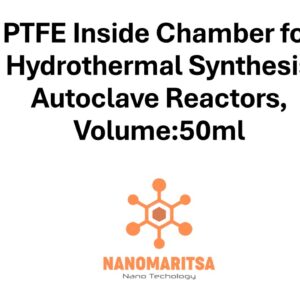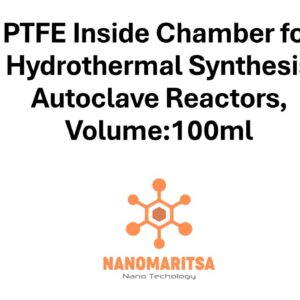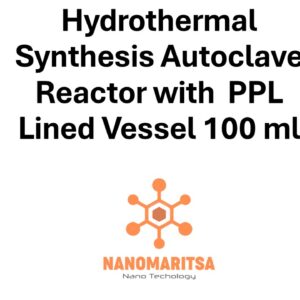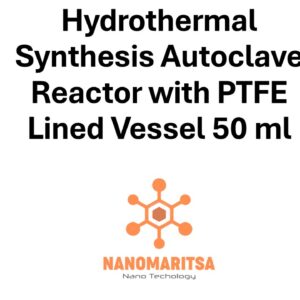PPL Inside Chamber for Hydrothermal Synthesis Autoclave Reactors, Volume:100ml
€192.00
ComparePPL Inside Chamber for Hydrothermal Synthesis Autoclave Reactors (100 ml) is a chamber designed for conducting hydrothermal synthesis reactions, typically under high-pressure and high-temperature conditions. It features an inner lining made from Polyphenylene Sulfide (PPL), a high-performance polymer known for its chemical and thermal stability. This chamber is an essential component of hydrothermal reactors used for synthesizing nanomaterials, crystals, and advanced materials. Here’s a detailed overview:
1. Key Features:
- PPL Lining: The chamber is lined with Polyphenylene Sulfide (PPL), which provides excellent resistance to a wide range of chemicals, including acids, bases, and solvents. This ensures that the reactor’s internal environment remains stable and uncontaminated by the chamber material during synthesis.
- Volume (100 ml): With a 100 milliliter (ml) capacity, the chamber is suitable for medium-scale experiments. It provides enough space for multiple reactions or a larger amount of material than smaller-volume chambers, making it ideal for research or small-scale production.
- High-Pressure and High-Temperature Resistance: The PPL chamber is designed to withstand high pressures (up to 200-300 bar) and temperatures (150°C to 250°C), which are typically required for hydrothermal reactions. This makes it capable of creating the controlled environment necessary for material synthesis.
- Sealed Environment: The chamber is sealed inside the reactor, ensuring that the high-pressure and high-temperature conditions are maintained throughout the process. This helps in achieving precise and consistent results in material synthesis.
2. Properties:
- Chemical Resistance: The PPL material is highly resistant to a variety of chemicals, ensuring that it does not react with the substances inside the chamber, which is crucial for maintaining the purity of the synthesized products.
- Thermal Stability: PPL has excellent thermal stability, capable of withstanding high temperatures (up to 250°C) without degrading, making it suitable for the extreme conditions required in hydrothermal synthesis processes.
- Mechanical Strength: The PPL lining provides mechanical strength to the chamber, ensuring that it maintains its structural integrity under high-pressure conditions. This is important for ensuring the safety and reliability of the reactor.
- Non-reactivity: PPL is non-reactive with most substances, ensuring that it does not alter the course of the hydrothermal reaction and helps preserve the quality of the synthesized materials.
3. Applications:
- Nanomaterial Synthesis: This chamber is often used for synthesizing nanoparticles, nanowires, and other nanostructures. The high-pressure and high-temperature environment facilitates the formation of materials with specific properties, such as high surface area and tunable electronic characteristics.
- Crystal Growth: Hydrothermal synthesis is a widely used method for growing high-quality crystals, including metal oxides, semiconductors, and other inorganic compounds. The 100 ml chamber size allows for larger scale crystal growth experiments.
- Catalyst Synthesis: The chamber is ideal for the synthesis or modification of catalytic materials. The harsh conditions inside the chamber promote the formation of catalysts with enhanced performance for chemical reactions.
- Energy Materials: It is also used in the synthesis of energy-related materials such as electrodes for batteries, supercapacitors, and fuel cells. These materials often require precise control of their microstructure, which is facilitated by the chamber’s controlled environment.
- Environmental Applications: The chamber can be used for creating materials for environmental applications, such as catalysts for air or water purification, advanced filtration materials, and others aimed at pollution control or waste treatment.
4. Handling and Safety:
- Toxicity and Corrosiveness: While the PPL lining protects the chamber from reacting with most chemicals, the substances inside the chamber may still be toxic, corrosive, or hazardous. Proper safety precautions should be taken when handling chemicals used in the hydrothermal synthesis.
- Pressure and Temperature Safety: The chamber operates under high-pressure and high-temperature conditions, so it is crucial to ensure that the reactor is properly sealed and that there are no leaks. Safety protocols must be followed strictly to avoid accidents.
- Storage: After use, the chamber should be cleaned thoroughly to remove any residual chemicals. It should be stored in a safe, dry, and cool environment to avoid any damage to the PPL lining and maintain the chamber’s effectiveness.
- Precautions: Always use appropriate personal protective equipment (PPE), such as gloves, goggles, and lab coats, when handling the reactor. It is also important to ensure the reactor is used in a well-ventilated area or under a fume hood to minimize exposure to hazardous fumes or vapors.
Summary:
The PPL Inside Chamber for Hydrothermal Synthesis Autoclave Reactors (100 ml) is a robust and essential component for conducting controlled hydrothermal reactions. Its PPL lining ensures excellent chemical resistance, thermal stability, and mechanical strength, making it suitable for a variety of material synthesis processes under high-pressure and high-temperature conditions. The 100 ml volume makes it ideal for medium-scale experiments or synthesis of larger quantities of materials. Whether used for research, development, or small-scale production, this chamber plays a critical role in producing high-quality nanomaterials, crystals, catalysts, and energy materials.
| Pieces | 1 Piece, 5 Pieces |
|---|






